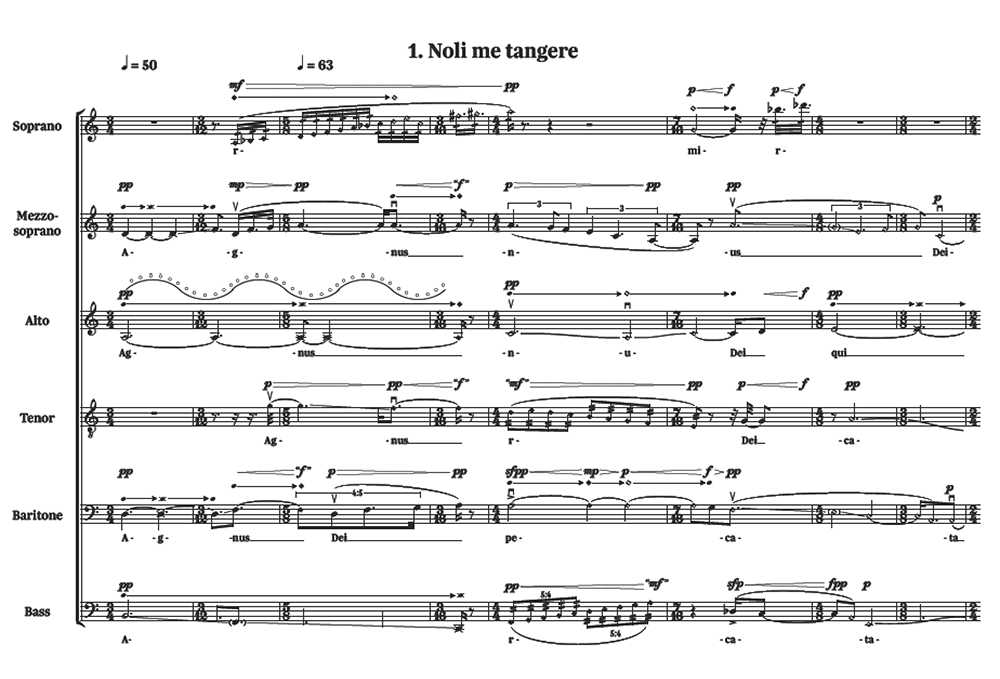Title: Das wassergewordene Kanonbuch
Instrumentation: 2 sopranos, alto, tenor, 2 basses
Year: 2016–17
Duration: 25 min.
Premiere: Musik der Zeit Festival Köln 2016
Performers: Neue Vocalsolisten Stuttgart
Das wassergewordene Kanonbuch (The turned-to-water book of canons)
1. Noli me tangere (Touch me not)
2. Die Zahlen (The numbers)
3. Hunc discas morem, si vis cantare tenorem: ut iacet attente, cantetur subdiapenthe (Learn the customs, if the tenor is sung: as it stands attentively, sung subdiapenthe)
4. Weissgrau (Whitegrey)
5. Dum tria percurris quatuor valet. Tertius unum subque diapason sed facit alba moras (While three traversed, four counts. Third octave but it makes delays one under a white)
6. Wo? (Where?)
7. Omnia per circuitum (Everything about)
8. Tenor crescit in duplo (Tenor augments in double)
9. Canon in Diapente (Canon at the fifth)
10. Cancer eat plenus sed redeat medius (Let the crab go full but return in half)
11. Reverte citius (Go back faster)
12. In gradus undenos descendant multiplicantes, consimilique modo crescent antipodes uno (They descend eleven steps multiplying, and in the same manner they increase in the opposite direction)
13. Scinde vestimenta tua redeundo (Rend your garments in returning)
14. Fuga trium temporum in diapente remissum (Fugue after three measures at the fifth below)
15. Pigmeus hic crescat, gigas decrescere debat/Incauda cerebrum, en est mirabile monstrum (Let the pygmy grow here, the giant should decrease/The brain is in the tail, behold the wonderous monster)
16. Canon ad septimam (Canon at the seventh)
17. Das Geschriebene (The written)
18. Noctem verterunt in diem/Etrursum post tenbas spero lucem (They have turned night into day, and after darkness I hope for light again)
19. Keine Sandkunst mehr (No sandart anymore)
20. Finis est principium (The end is the beginning)
Das wassergewordene Kanonbuch is a book of 20 canons for six voices where each canon reverse-transcribes a puzzle canon (Rätzelkanon) from the Medieval to Renaissance periods with reference to the poetry of Paul Celan. Each original puzzle canon is accompanied with a cipher that offers the key to their performance, i.e., when each voice should properly enter and under what conditions (diminution, augmentation, retrograde, transposition) in order to satisfy the rules of counterpoint of that period. Each title of a canon is properly named according to these ciphers. The exceptions are the five canons that are based upon five poems by Celan, that offer a different kind of cipher as something that does not require a solution but is rather a “letter in a bottle”:
“A poem … may be a letter in a bottle thrown out to sea with the—not always strong—hope that it may somehow wash up somewhere, perhaps on a shoreline of the heart. In this way, too, poems are en route: they are headed toward. Toward what? Toward something open, inhabitable, an approachable you, perhaps, an approachable reality.” (Paul Celan, “Speech on the Occasion of Receiving the Literature Prize of the Free Hanseatic City of Bremen,” 1958.)
If the ciphers of the puzzle canons require specific solutions, Celan’s poetry accomplishes the opposite by opening this book of canons to some other reality, one in which the numbers, proportions and relations of symmetry that are carefully woven into the music blend together with noise and materials that resist lyrical formation and cannot be easily grasped. This other reality searches for a listening where music no longer seems possible and lyrical expression is sensitive to relations between human impact and presence in our world of possible sounds. Such a listening can occur when music’s expressive aspects are broken and damaged and there is leakage between the compositional work and the larger world order.
The rhythmic and metric structure for each canon was derived from Prynne’s poem “Pearls That Were” which references Shakespeare’s The Tempest (i.e., “Full Fathom Five”).
Full fathom five thy father lies;
Of his bones are coral made;
Those are pearls that were his eyes:
Nothing of him that doth fade,
But doth suffer a sea-change
Into something rich and strange.
Sea-nymphs hourly ring his knell:
Ding-dong.
Hark! now I hear them,—ding-dong, bell.
William Shakespeare, The Tempest, 1610 –11
My first opera Die Geisterinsel (2010–11) was also based on the The Tempest. One can imagine Das wassergewordene Kanonbuch sung by the Geisterchor (choir of spirits) who are native to Prospero’s island as a postlude to my opera, once Prospero’s influence has disappeared and the spirits can again discover their music.
Caliban:
Diese Insel ist voll von Getöse,
Tönen und anmutigen Melodien, die belustigen und keinen Schaden tun
(The isle is full of noises,
Sounds and sweet airs that give delight and hurt not.)
Ming Tsao, Die Geisterinsel Libretto (from William Shakespeare and Friedrich Wilhelm Gotter)
Link: www.wisemusicclassical.com/work/67585/Das-wassergewordene-Kanonbuch–Ming-Tsao/


